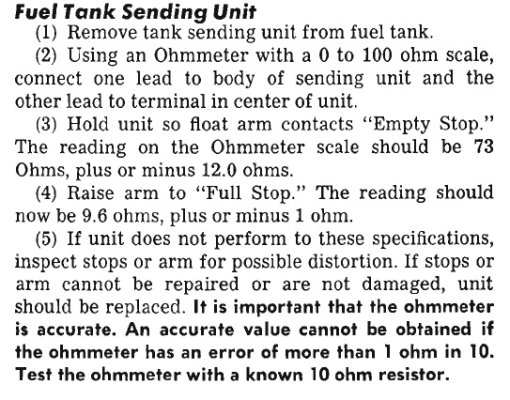- Local time
- 8:24 AM
- Joined
- May 14, 2011
- Messages
- 17,245
- Reaction score
- 32,447
- Location
- On the Ridge, TN
Recently, I obtained a "proper" fuel sending unit via Sale ad here on FBBO (thanks, @Road Grabber ).
Least, I think it is - I don't see any part numbers on it, but it appears to be an original...
3/8" out, 1/4" return line, all that jazz. Even has a sock still.
Anyways, today I decided to check it out in preparation for eventual installation in place of the piece
of CRAP Chinesium one in Fred now.
I remembered a recent discussion about the resistance test of one of these and decided to give it a go.
At first, nothing much was working, so I got inside the swinging part of the sender and cleaned up the
contact "sweep" and the little brass bobber thingy on the pendulum, then buttoned it back up.
I set my test meter to ohms and here's what I got:

Float arm resting against one of the stops...black ground probe tucked up under the corner of the outside
of the little box, wedged between it and the 3/8" tubing. Red probe is connected to the threaded stud where
the wire going to the gauge attaches....

Float arm sort of at 1/3 travel....

...and finally, float arm held up against the other stop.
I only was able to get these variable readings after doing some cleaning up of the contact surfaces of the inner
workings AND re-bending the little brass arm on the shaft coming in from the float so that it made really positive
contact with that isolated strip inside the box, the one with all the "teeth" on it.
(Funny side note: this strip showed what looked like "never got fill-ups" wear on it; the far end of one side of it
was noticeably less swept-upon than the bulk of the rest of the strip).
I'm thinking I've got the delicate little thing working again, so now I need to go about making it a bit more bulletproof
before I go to all the hassle of getting under the car and swapping it for the junk sender in there now.
Suggestions?
Example: One of the three tabs that holds the little box together is broken off, so I'll want to give a few spot solderings
along that edge of the seam I think.
BTW, question: Now, don't make fun of me, but I'm not sure what the meter readings mean - seems like a swing of 50
ohms or so? My meter (I think a decent one) only has one ohms ("continuity") position on the switch. Are these numbers
good or do they indicate an overall issue?
Thanks in advance!
Least, I think it is - I don't see any part numbers on it, but it appears to be an original...
3/8" out, 1/4" return line, all that jazz. Even has a sock still.
Anyways, today I decided to check it out in preparation for eventual installation in place of the piece
of CRAP Chinesium one in Fred now.
I remembered a recent discussion about the resistance test of one of these and decided to give it a go.
At first, nothing much was working, so I got inside the swinging part of the sender and cleaned up the
contact "sweep" and the little brass bobber thingy on the pendulum, then buttoned it back up.
I set my test meter to ohms and here's what I got:
Float arm resting against one of the stops...black ground probe tucked up under the corner of the outside
of the little box, wedged between it and the 3/8" tubing. Red probe is connected to the threaded stud where
the wire going to the gauge attaches....
Float arm sort of at 1/3 travel....
...and finally, float arm held up against the other stop.
I only was able to get these variable readings after doing some cleaning up of the contact surfaces of the inner
workings AND re-bending the little brass arm on the shaft coming in from the float so that it made really positive
contact with that isolated strip inside the box, the one with all the "teeth" on it.
(Funny side note: this strip showed what looked like "never got fill-ups" wear on it; the far end of one side of it
was noticeably less swept-upon than the bulk of the rest of the strip).
I'm thinking I've got the delicate little thing working again, so now I need to go about making it a bit more bulletproof
before I go to all the hassle of getting under the car and swapping it for the junk sender in there now.
Suggestions?
Example: One of the three tabs that holds the little box together is broken off, so I'll want to give a few spot solderings
along that edge of the seam I think.
BTW, question: Now, don't make fun of me, but I'm not sure what the meter readings mean - seems like a swing of 50
ohms or so? My meter (I think a decent one) only has one ohms ("continuity") position on the switch. Are these numbers
good or do they indicate an overall issue?
Thanks in advance!


















